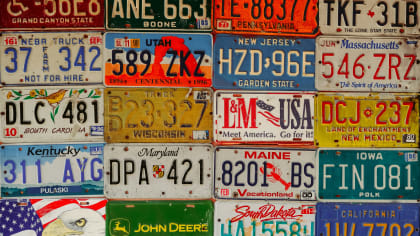NASCAR’S ENTIRE HISTORY
in less than 1000 words
This article is from our archives and has not been updated and integrated with our "new" site yet... Even so, it's still awesome - so keep reading!
Published on Wed, Mar 20, 2013
By: The LACar Editorial Staff

By Brian Kennedy
What’s a NAS-CAR anyway? It’s a fair question, but you’ve asked it kind of wrong. NASCAR is the National Association for Stock Car Auto Racing, a sanctioning body which puts on 36 points-paying races per year in its top series at tracks stretching from Daytona, Florida to Sonoma, California, and this weekend, Fontana.
What? You knew that? Did you know that the cars, which have been redesigned for this season, now resemble their stock counterparts more than they have in years?
In the old days (NASCAR history goes back over half a century) stock cars were just that, kind of like today’s SCCA racers. You taped up the headlights, opened the exhaust, and ran. Over time, the cars in NASCAR changed, and when true “stock” cars—that is, what you could buy in the dealership and drive on the street—mostly switched from being V8 rear-wheel drive models to being 6-cylinder front-drivers, NASCAR stayed with the old formula.

Hence while they have featured cars that are named after their stock counterparts, there hasn’t been much that’s been stock about them. That’s changing. But first, some history.
The big change away from stock came in the 1980s. During that decade, some of you will recall, the Olds Cutlass, Buick Regal, and Chevy Monte Carlo were all essentially similar machines, all rear-drive, albeit changed mightily from the muscle car days. The main changes were that the cars were no longer the ground-pounding monsters they had been in the 1960s and to a lesser extent, the 70s. They were instead choked-down versions of their elder cousins replete with low compression engines, smog equipment adding tangles of hoses to already anemic performance.
But still, they were rear-drive, and the cars on the NASCAR then-Winston Cup circuit looked much like what was in showrooms. With the 1988 model year, that changed. Remember the “This is not your father’s Oldsmobile” commercials? The cars they sold were now front-drive, with nary a V8 engine in sight. In fact, the attempt to wean America off of petrol-guzzlers coincided with turning the engines sideways and even including some 4-bangers in the product mix.

Still NASCAR persisted in creating “stock” cars out of the silhouettes of these bodies. “Silhouettes” because in fact, these were not production-based chassis, but purpose-built race cars maximized for speed. (Safety considerations would dominate in a later generation.) The one with the most similarity between street and track versions was the Ford Thunderbird, which continued in rear-drive configuration until 1997. The engines available were V6s and V8s including the 302 CID model and the Mustang’s 4.6-litre V8.
None of these engines made it onto the NASCAR circuit, because all the powerplants there are governed by a set of rules which sets maximum displacement at 358 cubic inches. Naturally, no one, given the chance to max at that number, is going to run a smaller displacement.
Hence by the 1990s, neither bodies nor engines were all that stock. However, that does not mean that the cars were not, in a sense, Chevys, Fords, later Dodges, etc., because the manufacturers have always been heavily involved in engine development. And they used to be and may once again be involved in body shape. Back in the 1990s, the cars were required to display the overall shape of their production counterparts, and this led to arguments and demands that various makes be tweaked after initial runs to give a better aero balance. The arguments were sometimes vociferous, and it might have been this back-and-forth that led the series to design a car, called the “Car of Tomorrow,” which debuted in 2007 and had two defining features.
One was a much greater attention to safety than had been offered in earlier cars. While NASCAR has maintained pace with safety developments, albeit to some eyes a little slowly, this car was bigger, with the driver more centered than he/she had been for greater impact safety. The roof escape hatch became mandatory.
The other thing about the COT was that the manufacturers, by this point Toyota, Dodge, Ford, and Chevrolet, lost some of their distinction because all four models essentially shared the same outline. Their differentiation was in the shape of their noses and the stickered-on headlights and taillights that were a nod to their stock counterparts.

Coincidentally or not, the rise of this car coincided with a decline in NASCAR’s success. Other reasons for this were legion—the disappearance of the older generation of drivers who so many fans adored (Dale Jarrett, retired; Dale Earnhardt, killed at Daytona), an economic crisis which robbed people of their entertainment budgets and corporations of their ability to sponsor teams at high-dollar levels.
So the sanctioning body, never one to sit still, took action. For the 2013 season, the NASCAR stock car in the Sprint Cup division is all-new. Whereas the cars of tomorrow were about ninety percent identical, whether Fords, Chevys, Toyotas, or Dodges, now, while Dodge has dropped out, the remaining three marques have carved distinct bodies for their entries. The Toyota now has the bodylines of a Camry, the Ford the Fusion, and the Chevy the new model SS. It is said that they are at present about ninety percent different one from another.
In addition, they are lighter, and their design is supposed to allow for more racing due to aerodynamic changes. The bumpers do not line up, as they did on the prior models, which is intended to stop cars drafting in a line. It also speaks to the “different marques, different shapes” idea already cited.
So to bring this back to you, the LA Car reader, let’s just say that if you think you’ve seen NASCAR because you’ve been out to the Auto Club Speedway in a recent year to watch them race, you haven’t. The “win on Sunday, sell on Monday” mantra of days gone by is more true today than it has been in a while, as the cars do remind one quite handily of what can be taken home from a local dealership. And if the Chevrolet SS is your dream, then that car, available soon, is rear-wheel drive, and so even more like the “stock” counterpart that races.

The new car, it must be said, has not received universal praise from drivers yet. It seems, according to media reports, that they feel it is not possible to pass with the car. In fact, Denny Hamlin, driver of the Toyota Camry sponsored by FedEx, said as much after an early season race, the second of the year. For his words, he was issued a fine of $25,000. His response was that from now on, he will tell the truth in answer to questions when it agrees with NASCAR’s point of view, but when he’s got a contrary opinion, he will invoke the “no comment” priviledge. Fellow racer Jeff Burton, according to an SI.com article, said that the sanctioning body has put a tremendous amount of time into creating a car for the fans to enjoy.
That leaves a couple of questions for Fontana: will the cars, which are constantly undergoing tweaks to their aero, tires, and suspensions in order to achieve maximum competitiveness, be more dicey in traffic? And if not, will drivers have something to say about that?
You can see, already, that there’s controversy afoot. But that’s not the purpose of this story. For that, you’ll have to tune in a couple of days. In the meantime, tickets for the weekend’s races can be had at www.autoclubspeedway.com. Buy one, and you can see for yourself how this car looks (incredible) and how it drives (fast).





